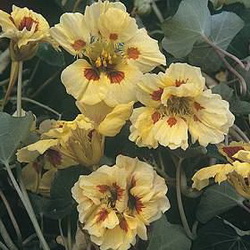Nasturtium Jewel
Nasturtium jewel is a beautiful climbing species that provides vibrant blooms and rich foliage. The plants can easily grow to more than eight feet in height. During the summer months they typically provide varying shades of yellow, orange, maroon and cream along with other shades that may include peach, scarlet and apricot. The colors resemble jewels, hence the name. Leaves from the nasturtium jewel are large and marbled with white. Both the leaves and the flowers from the plant are edible and provide a spicy flavor. They are widely found today covering many herb gardens and used for edging. Climbing varieties are often used on garden trellises or lower fences to provide a beautiful splash of color.
Caring for Nasturtium Jewel
The plants themselves are very easily cared for and typically require very little maintenance. It should be noted that nasturtium jewels are prone to aphids as well as flea beetles, white flies, slugs and caterpillars. Because the plant is edible it is recommended that pesticides not be used to protect against insect infestation. Instead, simply washing the plants with mild soap and warm water should suffice. Seeds can be sown in early spring after the last frost and in warmer climates can be sown during mid to late fall and grown throughout the winter. Those in colder climates who want to enjoy the flowers during the winter months can easily grow them indoors. They thrive in drier soils so take care not to over water them. Too much water as well as using fertilizer and other plant foods will cause the foliage to grow very thick and provide fewer flowers. They make an excellent selection for beginner's or children's gardens as they are very easy and fast to grow and require little care.
Harvesting
You can harvest your nasturtium jewel plants when the flowers are completely open. The leaves can be harvested at any time once they begin to grow and make an excellent addition to a variety of dishes. Because of the peppery flavor, these plants are recommended for companion plants. They will help to dispel cucumber beetles and other insects from plants in your vegetable garden. If you are planning to harvest the seeds, which are also edible, you should wait until they have dried on the plant. This is typically after the flower blooms have wilted. Seeds are used widely in a number of recipes and can be a very inexpensive alternative to using capers.
Sowing Seeds
Seeds of the nasturtium jewel should be sown directly into your garden soil after the last frost. No soil preparation is needed. You simply have to ensure that you push the seeds about ½ inch to 1 inch below the soil surface and plant them at least ten to fifteen inches apart. Seeds typically germinate in about seven to ten days and you should begin seeing blooms in approximately 55 to 65 days after seeding. Be sure to plant nasturtium jewel in direct sunlight and in dry, lean soil.
